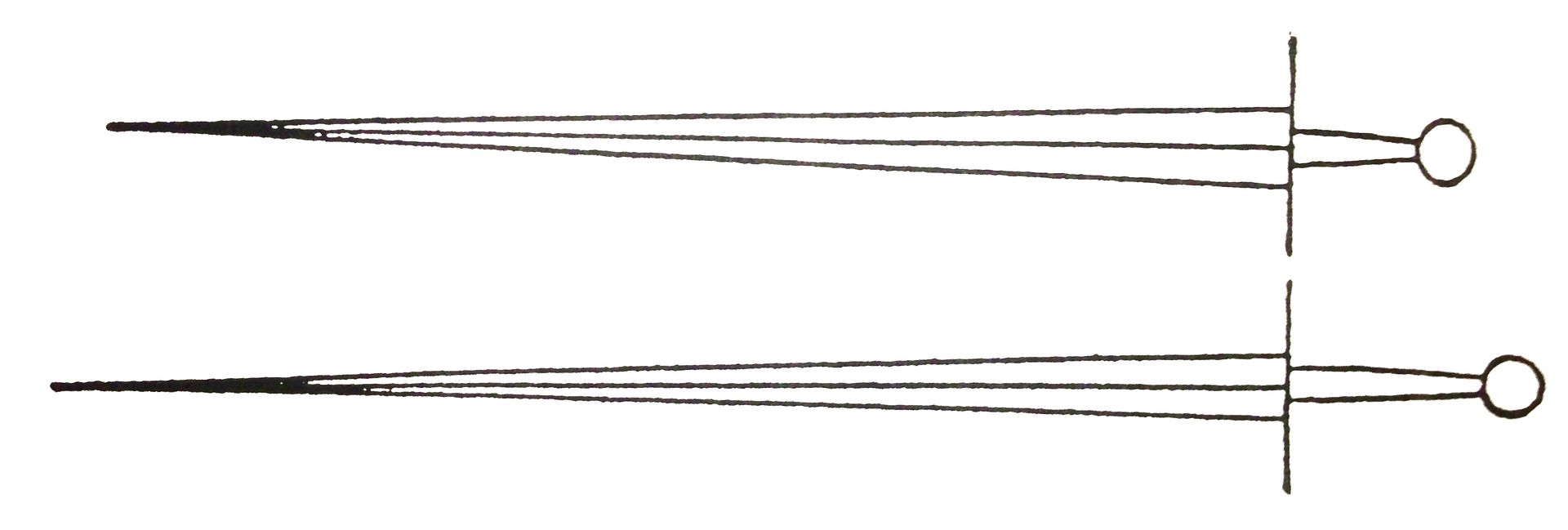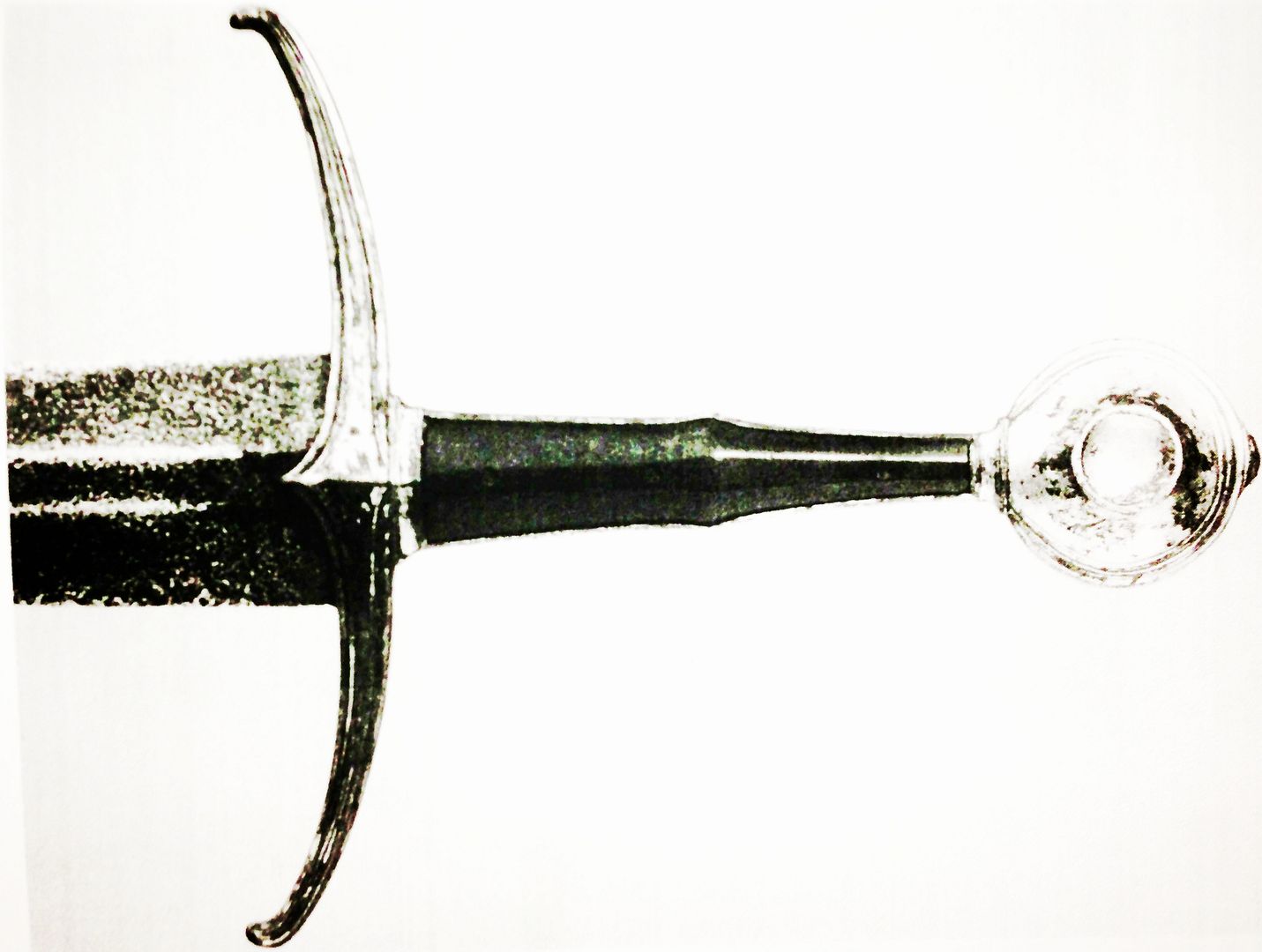Oakeshott Type XV - XVa - Records of the Medieval Sword
Jul 12, 2013 15:27:00 GMT
Post by Jack Loomes on Jul 12, 2013 15:27:00 GMT
Link to Sword-Site's Collection of Original Historic Type XV - XVa Swords Here: sword-site.com/board/26/oakeshott-type-xv-xva-swords
Extract from Ewart Oakeshott's Records of the Medieval Sword
Type XV - XVa
The general outline, or silhouette, of this type is very much like that of Type XIV, but the section of the blade is totally different, as is the prime function of the sword. The XIV's were made and used when the most defensive armour was still mail, with or without metal or leather of quilted reinforcement. The function of a XIV, like all it [sic] predecessors, was to be a slashing and hewing weapon. A XV was meant to be able to deliver a lethal thrust, even though armour was largely of plate. It seems to have developed along with the development of plate armour. Here, however, I must add a ride. Many of the swords in the period of the Celtic Iron Age, particularly in the La Tene III, are of the same stiff, flattened diamond section with a prime function of thrusting. The long Roman Spatha, used by the ancillary cavalry, is of a form which, if found or seen out of context, could well be taken to be the lade of a sword of Type XV or XVIII of the 14th or 15th century A.D., instead of between 200 B.C. and 400 A.D.
The illustrations and notes which follow will demonstrate the form and general appearance of the type and its long gripped, hand a half subtype, which by the 15th century would be called and Épée bâtarde, or Bastard Sword. With this type, unlike some of its predecessors, dating becomes impossible without some kind of firm evidence, preferably external or contextual, for the type was popular from the late 13th century to the late 15th - indeed, the blade-form continued in use into the 19th century. Considering we find it first in the 3rd century BC contexts, it must be the most long-lived blade form in the Western world.

XV. 4
Type: XV
Find-place: unknown
Collection: Private. Ex. author, ex Douglas Ash
Blade-length: 27" (68cms)
Pommel-type: G.1
Cross-style: 10
Date: C.1470-1500
Condition: Excellent. Must have been preserved in an armoury or in a house, and cared for. The hilt retains most of its original blue colour, as well as its grip of ? lime wood covered with red velvet and bound with silver wire. This grip shows interesting marks of wear, the velvet covering being worn away where the heel of a hand has rubbed it and there is a good deal of hand-grease where it was gripped. There is a mark of a small cross inlaid in copper on the blade, which is of extremely thick section. Rather a a heavy sword, well balanced for thrusting.
Publication: Oakeshott, AOW pl.19; Oakeshott, SAC pl.27b


XV. 9
Typec: XV
Find-place: Unknown
Collection: Metropolitan Museum of Art, New York
Blade-length: 29" (73.7cms)
Pommel-type: K
Cross-style 8, curved
Date: c.1400-50
Condition: Not excavated, but preserved indoors. The blade shows a lot of quite deep overall surface pitting as if it had been allowed to get very rusty; but the hilt of gilt-bronze with a horn grip is in near perfect condition.
The very elegant grip of dark greenish-black horn is held by long vertical fillets of gilt-bronze along each edge. It is a most elegant, useful sword which has had doubts cast upon its authentic age, being held by some authorities to be a 19th century fake.
Publication: New York, Metropolitan Museum Bulletin
Oakeshott, SAC, pl. 23 and 24


XVa. 1
3. Type: XVa
Find-place: Lake of Lucerne
Collection: The Royal Armouries. Ex collection Sir Edward Barry
Blade-length: 32" (81 cms) approximately
Pommel-type: J
Cross-style: 8
Date: c.1350-70
Condition: Poor. There is a lot of deep pitting underneath the patina, but the old grip survives though the metal of the hilt is badly corroded, as is the lower on-third of the blade. An extremely simliar sword, in the same kind of condition though lacking the grip was found in the Thames at London, and is now in the collection of the Society of Antiquaries at Burlington House in London. The form of sword seems to have been fashionable in the 14th century, judging by the number of survivors, all as alike as peas in a pod.
Publication: Laking, Connoisseur, February, 1905. Dufty.

Oakeshott Sword Type X: sword-site.com/thread/118/oakeshott-type-records-medieval-sword
Oakeshott Sword Type Xa: sword-site.com/thread/123/oakeshott-type-records-medieval-sword
Oakeshott Sword Type XI - XIa: sword-site.com/thread/126/oakeshott-type-records-medieval-sword
Oakeshott Sword Type XII: sword-site.com/thread/127/oakeshott-type-records-medieval-sword
Oakeshott Sword Type XIIa: sword-site.com/thread/128/oakeshott-type-records-medieval-sword
Oakeshott Sword Type XIII - XIIIb: sword-site.com/thread/152/oakeshott-xiiib-records-medieval-sword
Oakeshott Sword Type XIV: sword-site.com/thread/159/oakeshott-type-records-medieval-sword
Oakeshott Sword Type XV - XVa: sword-site.com/thread/166/oakeshott-type-records-medieval-sword
Oakeshott Sword Type XVI - XVIa: sword-site.com/thread/167/oakeshott-type-records-medieval-sword
Oakeshott Sword Type XVII: sword-site.com/thread/175/oakeshott-type-records-medieval-sword
Oakeshott Sword Type XVIII - XVIIIa: sword-site.com/thread/183/oakeshott-xviii-xviiia-records-medieval
Oakeshott Sword Type XIX: sword-site.com/thread/187/oakeshott-type-records-medieval-sword
Oakeshott Sword Type XX - XXa: sword-site.com/thread/200/oakeshott-type-records-medieval-sword
Oakeshott Sword Type XXI - XXII: sword-site.com/thread/204/oakeshott-type-records-medieval-sword
Diagram of Oakeshott's Sword Types: sword-site.com/thread/251/index-ewart-oakeshotts-medieval-typologies
Extract from Ewart Oakeshott's Records of the Medieval Sword
Type XV - XVa
The general outline, or silhouette, of this type is very much like that of Type XIV, but the section of the blade is totally different, as is the prime function of the sword. The XIV's were made and used when the most defensive armour was still mail, with or without metal or leather of quilted reinforcement. The function of a XIV, like all it [sic] predecessors, was to be a slashing and hewing weapon. A XV was meant to be able to deliver a lethal thrust, even though armour was largely of plate. It seems to have developed along with the development of plate armour. Here, however, I must add a ride. Many of the swords in the period of the Celtic Iron Age, particularly in the La Tene III, are of the same stiff, flattened diamond section with a prime function of thrusting. The long Roman Spatha, used by the ancillary cavalry, is of a form which, if found or seen out of context, could well be taken to be the lade of a sword of Type XV or XVIII of the 14th or 15th century A.D., instead of between 200 B.C. and 400 A.D.
The illustrations and notes which follow will demonstrate the form and general appearance of the type and its long gripped, hand a half subtype, which by the 15th century would be called and Épée bâtarde, or Bastard Sword. With this type, unlike some of its predecessors, dating becomes impossible without some kind of firm evidence, preferably external or contextual, for the type was popular from the late 13th century to the late 15th - indeed, the blade-form continued in use into the 19th century. Considering we find it first in the 3rd century BC contexts, it must be the most long-lived blade form in the Western world.

XV. 4
Type: XV
Find-place: unknown
Collection: Private. Ex. author, ex Douglas Ash
Blade-length: 27" (68cms)
Pommel-type: G.1
Cross-style: 10
Date: C.1470-1500
Condition: Excellent. Must have been preserved in an armoury or in a house, and cared for. The hilt retains most of its original blue colour, as well as its grip of ? lime wood covered with red velvet and bound with silver wire. This grip shows interesting marks of wear, the velvet covering being worn away where the heel of a hand has rubbed it and there is a good deal of hand-grease where it was gripped. There is a mark of a small cross inlaid in copper on the blade, which is of extremely thick section. Rather a a heavy sword, well balanced for thrusting.
Publication: Oakeshott, AOW pl.19; Oakeshott, SAC pl.27b


XV. 9
Typec: XV
Find-place: Unknown
Collection: Metropolitan Museum of Art, New York
Blade-length: 29" (73.7cms)
Pommel-type: K
Cross-style 8, curved
Date: c.1400-50
Condition: Not excavated, but preserved indoors. The blade shows a lot of quite deep overall surface pitting as if it had been allowed to get very rusty; but the hilt of gilt-bronze with a horn grip is in near perfect condition.
The very elegant grip of dark greenish-black horn is held by long vertical fillets of gilt-bronze along each edge. It is a most elegant, useful sword which has had doubts cast upon its authentic age, being held by some authorities to be a 19th century fake.
Publication: New York, Metropolitan Museum Bulletin
Oakeshott, SAC, pl. 23 and 24


XVa. 1
3. Type: XVa
Find-place: Lake of Lucerne
Collection: The Royal Armouries. Ex collection Sir Edward Barry
Blade-length: 32" (81 cms) approximately
Pommel-type: J
Cross-style: 8
Date: c.1350-70
Condition: Poor. There is a lot of deep pitting underneath the patina, but the old grip survives though the metal of the hilt is badly corroded, as is the lower on-third of the blade. An extremely simliar sword, in the same kind of condition though lacking the grip was found in the Thames at London, and is now in the collection of the Society of Antiquaries at Burlington House in London. The form of sword seems to have been fashionable in the 14th century, judging by the number of survivors, all as alike as peas in a pod.
Publication: Laking, Connoisseur, February, 1905. Dufty.

Oakeshott Sword Type X: sword-site.com/thread/118/oakeshott-type-records-medieval-sword
Oakeshott Sword Type Xa: sword-site.com/thread/123/oakeshott-type-records-medieval-sword
Oakeshott Sword Type XI - XIa: sword-site.com/thread/126/oakeshott-type-records-medieval-sword
Oakeshott Sword Type XII: sword-site.com/thread/127/oakeshott-type-records-medieval-sword
Oakeshott Sword Type XIIa: sword-site.com/thread/128/oakeshott-type-records-medieval-sword
Oakeshott Sword Type XIII - XIIIb: sword-site.com/thread/152/oakeshott-xiiib-records-medieval-sword
Oakeshott Sword Type XIV: sword-site.com/thread/159/oakeshott-type-records-medieval-sword
Oakeshott Sword Type XV - XVa: sword-site.com/thread/166/oakeshott-type-records-medieval-sword
Oakeshott Sword Type XVI - XVIa: sword-site.com/thread/167/oakeshott-type-records-medieval-sword
Oakeshott Sword Type XVII: sword-site.com/thread/175/oakeshott-type-records-medieval-sword
Oakeshott Sword Type XVIII - XVIIIa: sword-site.com/thread/183/oakeshott-xviii-xviiia-records-medieval
Oakeshott Sword Type XIX: sword-site.com/thread/187/oakeshott-type-records-medieval-sword
Oakeshott Sword Type XX - XXa: sword-site.com/thread/200/oakeshott-type-records-medieval-sword
Oakeshott Sword Type XXI - XXII: sword-site.com/thread/204/oakeshott-type-records-medieval-sword
Diagram of Oakeshott's Sword Types: sword-site.com/thread/251/index-ewart-oakeshotts-medieval-typologies

.png?width=1920&height=1080&fit=bounds)